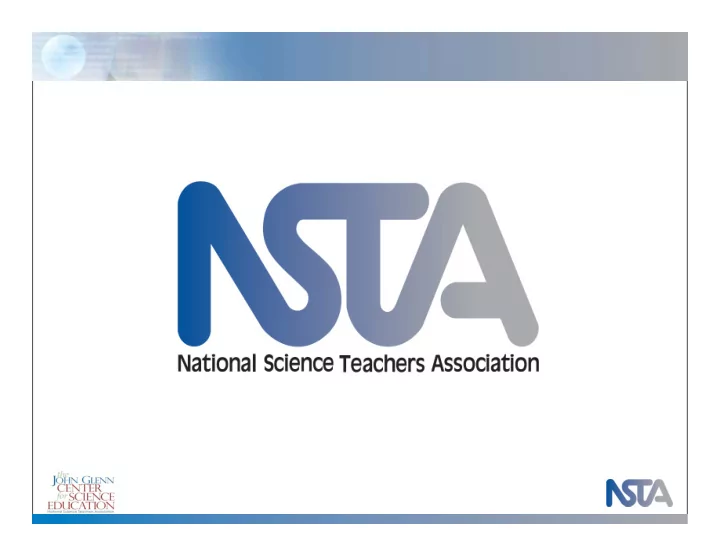

The National Science Teachers Association's mission is to promote excellence and innovation in science teaching and learning for all.
What NSTA Does � Core Business � Conferences (PD) � Books/Publications � Advocacy � Priority Areas � New Science Teachers Academy � E-Portal (Learning Center) � International � Urban Science Education Leaders
STEM – What do you think STEM means?
NSTA’s View of S.T.E.M Practice (Science Ed) Policy (STEM) Instruction Advocacy The Field Materials •Legislation 1. Design & I mplementation Professional Develop. •Corporate Questions •Careers Programs •Collaborations Research STEM Education Coalition, Standards Legislative Conference
What is NSTA doing in S.T.E.M. � STEM Explorations � NSTA STEM Task Force � STEM Meeting of organizations in DC � Online and print resources at NSTA � Conferences � Competitions � Next Generation of Science (and Engineering) Standards
S.T.E.M. Meeting in DC � Does your organization view STEM education as having a multi-disciplinary focus or a single focus, and how does your organization handle the differences? � What research informs your organization’s understanding of STEM education and its application? � Is the definition of STEM education in policy discourse different than when it is implemented in schools? � What research needs to be done with respect to the four disciplines in order to support successful implementation of STEM education in schools?
Two Questions � What research informs your (organization’s) understanding of STEM education and its application? � Is the definition of STEM education in policy discourse different than when it is implemented in schools?
Practical Issues: From the DC group � Time Constraints � Teacher Professional Development � Content � Skills and Practice � Teacher Preparation � Assessments � Alignment � STEM Schools
Proposed S.T.E.M. School Study Criteria � STEM-focused Curriculum � Reform Instructional Strategies/Project-based Learning � Integrated, Innovative Technology Use � Blended Formal/Informal Learning beyond the Typical School Day, Week, or Year � Real-world STEM Partnerships � Early College-level Coursework � Well-Prepared STEM Teaching Staff � Inclusive STEM Mission � Administrative Structure � Special Supports for Underrepresented Students
Suggestions for Defining STEM? � Science, Technology, Engineering and Mathematics � Separate and or Applied, project based courses � Meta-discipline � the creation of a discipline based on the integration of other disciplinary knowledge (Morrison, 2009.) � Trans-disciplinary � offers a multi-faceted whole with greater complexities (Kaufman, et all 2003.)
What do you think? � What do we need to provide for guidance to K-12 STEM educators? � What do you need as engineering educators? � What do we need as science educators? � Who has to be involved that is not now? � Can NSTA assist and if so how? � Other?
Thank You Francis Eberle – feberle@nsta.org Ed Rock – erock@nsta.org
Recommend
More recommend